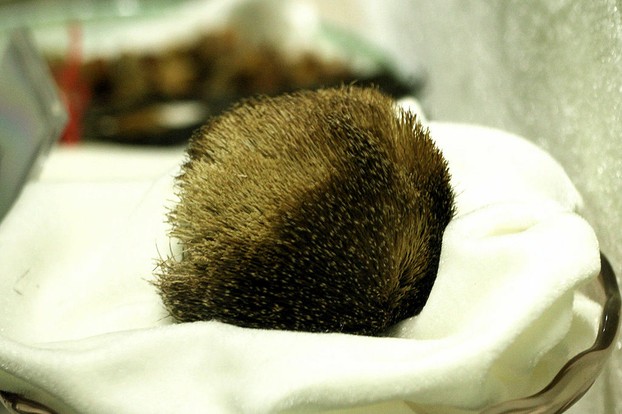“Ancient Villages in Southern Anhui -- Xidi and Hongcun.” WHC.UNESCO.org: UNESCO > Culture > World Heritage Centre > The List > World Heritage List. Retrieved November 11, 2014.
- Available at: http://whc.unesco.org/en/list/1002
“Anhui Musk Deer Moschus anhuiensis Wang, Hu & Yan, 1982.” BioLib.cz: Taxon Profile > Species. Retrieved November 11, 2014.
- Available at: http://www.biolib.cz/en/taxon/id299897/
Baskin, Leonard. 2003. "Musk Deer (Moschinae)." Pp. 335-338 in Grzimek's Animal Life Encyclopeda, 2nd edition. Volume 15, Mammals IV, edited by Michael Hutchins, Devra G. Kleiman, Valerius Geist, and Melissa C. McDade. Farmington Hills, MI: Gale Group.
Bisby, F.A.; Roskov, Y.R.; Orrell, T.M.; Nicolson, D.; Paglinawan, L.E.; Bailly, N.; Kirk, P.M.; Bourgoin, T.; Baillargeon, G.; and Ouvrard, D. (red.). 2011. "Moschus anhuiensis Wang, Hu, and Yan, 1982." Species 2000 & ITIS Catalogue of Life: 2011 Annual Checklist. Reading, UK. Retrieved November 11, 2014.
- Available at: http://www.catalogueoflife.org/col/details/species/id/19742793
Cuvier, Fréderic. 1816 - 1829. Dictionnaire des sciences naturelles: Planches. 2e partie: règne organisé. Zoologie, Mammiféres. Paris: F.G. Levrault.
- Available via Biodiversity Heritage Library at: http://biodiversitylibrary.org/page/24392850
Finn, Frank. n.d. The Wild Beasts of the World. Illustrated with 100 Reproductions in Full Colours from Drawings by Louis Sargent, Cuthbert E. Swan, and Winifred Austin. Volume Two. London: T.C. & E.C. Jack.
- Available via Biodiversity Heritage Library at: http://biodiversitylibrary.org/page/19080293
Flerov, Konstantin Konstantinovich. 1952. Musk Deer and Deer. Moscow, Russia: Academy of Sciences of the USSR.
Groves, C.P. 2011. "Family Moschidae (Musk-Deer)." In Handbook of the Mammals of the World. Volume 2: Hooved Mammals edited by D.E. Wilson and R.A. Mittermeier. Barcelona, Spain: Lynx Edicions.
Groves, C. P.; Yingxiang, W.; and Grubb, P. 1995. "Taxonomy of Musk-Deer, Genus Moschus (Moschidae, Mammalia)." Acta Theriologica Sinica 15(3):181-197.
Grubb, P. 2005. "Artiodactyla." Pp. 637-722 in Mammal Species of the World. A Taxonomic and Geographic Reference (3rd Edition) Edited by D.E. Wilson and D.M. Reeder. Baltimore, MD: Johns Hopkins University Press.
"Moschus anhuiensis (Anhui Musk Deer)." Encyclopedia of Life. Retrieved November 11, 2014.
- Available at: http://eol.org/pages/7240172/details
"Moschus anhuiensis (Anhui Musk Deer)." ZipcodeZoo: Species Identifier 4753182. Retrieved November 11, 2014.
- Available at: http://zipcodezoo.com/animals/m/moschus_anhuiensis/
“Moschus anhuiensis Wang, Hu, and Yan, 1982.” ITIS Report: Taxonomic Serial No. 898195. Integrated Taxonomic Information System. Retrieved November 11, 2014.
"Mount Huangshan." WHC.UNESCO.org: UNESCO > Culture > World Heritage Centre > The List > World Heritage List. Retrieved November 11, 2014.
- Available at: http://whc.unesco.org/en/list/547
Nowak, R.M. 1999. Walker’s Mammals of the World. Sixth edition. Baltimore, MD; and London, England: The Johns Hopkins University Press.
Pickrell, John. 7 September 2004. “Poachers Target Musk Deer for Perfumes, Medicines.” National Geographic.com: News. Retrieved November 2014.
- Available at: http://news.nationalgeographic.com/news/2004/09/0907_040907_muskdeer.html
Rue, Dr. Leonard Lee III. 2003. The Encyclopedia of Deer: Your Guide to the World's Deer Species, Including Whitetails, Mule Deer, Caribou, Elk, Moose, and More. Stillwater MN: Voyageur Press.
Smith, A.; and Xie, Y. 2008. The Mammals of China. Princeton, NJ: Princeton University Press.
Su, B.; Wang, Y.X.; and Wang, Q. S. 2001. "Mitochondria DNA Sequences Imply Anhui Musk Deer a Valid Species in Genus Moschus." Zoological Research 22(3):169-173.
Su, B.; Wang, Y.X.; Lan, H.; Wang W.; and Zhang, Y. P. 2001. "Phylogenetic Study of Complete Cytochrome b Genes in Musk Deer (Genus Moschus) Using Museum Samples." Molecular Phylogenetics and Evolution 12(3):241-249.
Wang, Y.; and Harris, R.B. 2008. "Moschus anhuiensis." The IUCN Red List of Threatened Species. Version 2014.2. International Union for Conservation of Nature and Natural Resources. Retrieved November 11, 2014.
- Available at: http://www.iucnredlist.org/details/full/136643/0
Yang, Q. S.; Meng, X.X.; Xia, L.; and Lin Feng, Z.J. 2003. "Conservation Status and Causes of Decline of Musk Deer (Moschus spp.) in China." Biological Conservation 109:333-342.


















 Are Hawaiian Huakai Po Nightmarchers Avenging Halloween Thursday?on 10/02/2024
Are Hawaiian Huakai Po Nightmarchers Avenging Halloween Thursday?on 10/02/2024
 Mailing Addresses for 2023 Form 4868 Extending 1040 and 1040SR April 15, 2024, Due Dateon 04/15/2024
Mailing Addresses for 2023 Form 4868 Extending 1040 and 1040SR April 15, 2024, Due Dateon 04/15/2024
 Mailing Addresses for 2023 Forms 1040 and 1040SR Filed in 2024on 04/15/2024
Mailing Addresses for 2023 Forms 1040 and 1040SR Filed in 2024on 04/15/2024
 Mailing Addresses for 2022 Form 4868 Extending 1040 and 1040SR April 18, 2023, Due Dateon 04/13/2023
Mailing Addresses for 2022 Form 4868 Extending 1040 and 1040SR April 18, 2023, Due Dateon 04/13/2023



Comments